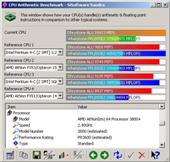AMD Athlon 64 FX-53 & 3800+: Socket 939 Has Arrived
How we configured our test systems: When configuring our test systems for this review, the first thing we did was enter the system BIOS and set each board to their "Optimized" or "High-Performance Defaults". We then manually configured our RAM to run at 200MHz (DDR400), with the timings set by the SPD. The hard drives were then formatted, and Windows XP Professional (SP1) was installed. When the installation was complete, we hit the Windows Update site and downloaded all of the available updates, with the exception of the ones related to Windows Messenger. Then we installed all of the necessary drivers, and removed Windows Messenger from the system altogether. Auto-Updating and System Restore were also disabled, and we setup a 768MB permanent page file on the same partition as the Windows installation. Lastly, we set Windows XP's Visual Effects to "best performance", installed all of our benchmarking software, defragged the hard drives and ran all of the tests...
|
| SYSTEM 1: S939 - AMD Athlon FX-53 (2.4GHz) S939 - AMD Athlon 64 3800+ (2.2GHz) MSI MS-6702E Motherboard VIA K8T800 Pro Chipset 2x512MB Corsair PC3200 CL2 Radeon 9800 Pro On-Board 10/100 Ethernet On-Board Audio WD "Raptor" 36GB Hard Drive 10,000 RPM SATA Windows XP Pro SP1 ATi Catalyst 4.3 DirectX 9.0b |
SYSTEM 2: AMD Athlon FX-53 (2.4GHz) AMD Athlon FX-51 (2.2GHz) Asus SK8N Motherboard nForce3 Pro 150 Chipset 2x512MB Mushkin PC3200 CL2 Registered Radeon 9800 Pro On-Board 10/100 Ethernet On-Board Audio WD "Raptor" 36GB Hard Drive 10,000 RPM SATA Windows XP Pro SP1 ATi Catalyst 4.3 DirectX 9.0b |
SYSTEM 3: AMD Athlon 64 3400+ (2.2GHz) Shuttle FN85 Motherboard nForce3 Pro 150 Chipset 2x512MB Kingston PC3500 CL2 - HyperX DIMMS Radeon 9800 Pro On-Board 10/100 Ethernet On-Board Audio WD "Raptor" 36GB Hard Drive 10,000 RPM SATA Windows XP Pro SP1 ATi Catalyst 4.3 DirectX 9.0b |
SYSTEM 4: Intel P4 3.2GHz Northwood Intel P4 3.2GHz Prescott Intel P4 3.4GHz E.E. Intel P4 3.4GHz Northwood Intel P4 3.4GHz Prescott DFI LANPARTY Pro875B Intel 875P Chipset 2x512MB Kingston PC3500 CL2 - HyperX DIMMS Radeon 9800 Pro On-Board 10/100 Ethernet On-Board Audio WD "Raptor" 36GB Hard Drive 10,000 RPM SATA Windows XP Pro SP1 ATi Catalyst 4.3 DirectX 9.0b |
|
We began our testing with SiSoftware's SANDRA, the System ANalyzer, Diagnostic and Reporting Assistant. SANDRA consists of a set of information and diagnostic utilities that can provide a host of useful information about your hardware and operating system. We ran four of the built-in sub-system tests that comprise the SANDRA 2004 suite (CPU, Multimedia, Cache and Memory). All of these tests were run with our Athlon 64 FX-53 and 3800+ CPUs set to their default clock speed of 2.4GHz (12 x 200MHz).
SANDRA's processor benchmark has the new Socket 939 Athlon 64's slightly ahead of the competition in the ALU tests, but they couldn't quite catch the HyperThreading enabled 3.2GHz Pentium 4 in the FPU tests. The Multimedia benchmark also shows the HT enabled P4s with a large performance advantage, but don't put too much stock in those numbers. SANDRA's synthetic test modules are heavily influenced by the P4's HyperThreading feature which doesn't universally affect performance.
In the Memory Bandwidth tests, the Athlon 64 FX-53 and 3800+ performed very well and surpassed every other reference system listed in SANDRA's internal database, including a "Canterwood" based system that had its memory clocked at PC4000 levels. The Cache & Memory benchmark scores were interesting to see. They showed the new Socket 939 and Socket 940 Athlons performing at near identical levels, until they reach a block size of 512K. The 3800+, which is based on the "Newcastle" core, had a sharp drop off once the block size exceeded 512K. The same thing happened to the FX-53 once the block size hit the 1MB mark. When compared to Intel CPUs, it seems like "Northwood" P4s were more efficient with smaller blocks of data (<512K), the FX-53 had an advantage with block sizes between 512K and 1MB, and the "Prescott" 2.8E performed best with larger block sizes.















